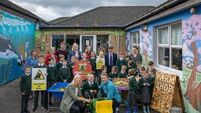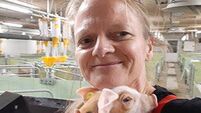A pollinator plan to put biodiversity at the heart of the landscape

It has been noted this week that some pollinators are facing extinction in Europe. File Picture.
The EU Commission highlighted this week that bees, butterflies, hoverflies, and moths have dramatically declined in Europe.
It warns that many species are also on the verge of extinction with one in three bee and butterflies declining in population and one in ten threatened with extinction.
The Commission says that the loss of wild pollinators is a serious cause for concern because around 80% of the crop and wild-flowering plant species in the EU depend on animal pollination.
Without pollinators, many plant species would decline and eventually disappear, and this, in turn, will threaten the survival of nature, human wellbeing, and the economy.
Here, at home, the All-Ireland Pollinator plan 2021-2025 was recently launched and sets out a five-year road map that aims to help bees, other pollinating insects, and the country’s wider biodiversity.
The focus is on delivering more actions and encouraging a better way of managing the landscape to permanently support biodiversity.
During a Teagasc ConnectEd Signpost Series webinar Dr Una Fitzpatrick, Senior Ecologist, National Biodiversity Centre and Chair and Project Manager, All-Ireland Pollinator Plan, discussed the biodiversity situation in more detail and highlighted how the All-Ireland Pollinator Plan will work.
She says there is “amazing” biodiversity in Ireland with 1,000 species in over 100 different habitats.
But, like the rest of Europe, in Ireland too, biodiversity loss is “a huge problem”.
“Pollinators are an element of biodiversity that people can understand and relate to,” she says.
“And they are a great way of detecting change.”
The service that bees provide is worth €59m per year to the economy, and their importance to human health and wellbeing cannot be understated.
In Ireland, over three-quarters of its wild plants need to be pollinated and so if there were no bees or other pollinators, the landscape would look totally different.
“Most pollination of crops and wild plants is carried out by bees and the rest is carried out by various other insects including flies,” added Dr Fitzpatrick.
“In Ireland, we have 99 different bees - the honey bee and 98 wild bees that comprise 21 types of bumblebees and 77 different solitary bees.
“Unfortunately one-third of the 98 species are threatened with extension.
“The abundance of bumblebees has been declining since 2012 and this is a consequence of the way in which we manage the landscape.”
One of the objectives of the new plan is to make farmland more pollinator-friendly and the aim, says Dr Fitzpatrick, “is to build from the ground up”.
The Department of Agriculture has agreed to provide funding for a Pollinator Officer that will assist with the objective and focus on more engagement, training, and access to knowledge exchange programmes.
More evidence-based resources will be established and more awareness around pollinators and biodiversity will be created around forestry and stud farms.
The All-Ireland Pollinator Plan 2021-2025 includes six objectives:
- To make farmland pollinator-friendly;
- To make public land pollinator-friendly so as to better coexist with biodiversity and help return food and shelter for pollinators to the island;
- To make private land pollinator-friendly including gardens, businesses, faith communities, and sports clubs;
- The implementation of an All-Ireland Honeybee Strategy that will support beekeepers and make honeybees part of a cohesive pollinator message that balances managed and wild pollinator populations;
- Conserve rare pollinators by raising awareness through dedicated initiatives;
- Strategic coordination of the Plan by raising awareness; addressing gaps in knowledge through research; and by tracking where pollinators occur and how populations are changing.










